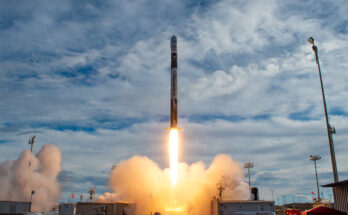by Bill Ostrove, Space Systems Analyst, Forecast International.
On October 30, 2017, SpaceX successfully launched the Koreasat-5A satellite from NASA’s Kennedy Space Center, Florida. Falcon 9 delivered the Koreasat-5A to its targeted orbit and the satellite was deployed approximately 36 minutes after liftoff.
Following stage separation, Falcon 9’s first stage successfully landed on the “Of Course I Still Love You” droneship, stationed in the Atlantic Ocean.
Built by Thales Alenia Space, Koreasat-5A is owned by KT SAT of South Korea. The satellite’s Ku-band transponders will be used to replace KT SAT’s Koreasat-5 and to expand the company’s capabilities to provide DTH broadcasting and other communications services in Korea, Japan, the Philippines, Guam, Indochina, and South Asia. It will also provide maritime services between East Asia and East Africa.
The launch is also significant for SpaceX. It is the 16th launch for the company in 2017, doubling its launch count for 2016. SpaceX has ambitions to revolutionize the space industry. One step toward achieving this goal is increasing its launch rate, a feat SpaceX is now proving that it can do.
With the launch, SpaceX’s Falcon 9 is now the 25th most used launch vehicle in the world, passing the Pegasus and Thorad launchers. By surpassing those two vehicles, the Falcon 9 also moves into 10th place for all-time use of an American launch vehicle.
SpaceX’s progress in ramping up its Falcon 9 launch rate has been impressive. As recently as late 2016, space industry observers were questioning if the company could succeed at all following the explosion of a Falcon 9 during prelaunch preparations in September. However, by conducting 16 launches, SpaceX appears to have emerged from those difficulties.
After the 16th launch in 2017, Forecast International took the opportunity to compare the launch rate of the Falcon 9 in its first eight years of operations to the launch rate of five popular competing launch vehicles over the same operational period.
The Falcon 9’s launch pace over its first eight years of operation has exceeded that of any of its current competitors. Only the Proton comes close to the Falcon 9, having launched 37 times between 1965 and 1973. While it has since become a major player in the market, China’s Long March 3 has the lowest number of launches in its first eight years of operation at only eight.
SpaceX has followed a gradual path toward out-launching its competitors. In the Falcon 9’s fourth year of operation only three vehicles lifted off, lower than the launch totals for the Soyuz and Proton and about equivalent to the rate for the Atlas V, which lifted off two times in its fourth year. Since then, however, SpaceX has increased its launch total every year, reaching 16 so far this year and with two months left.
This is not to say that the Falcon 9 achieved high launch rates faster than any other rockets. During the height of the Cold War, U.S. Thor rockets lifted off 190 times in the first eight years of the program’s life and Soviet Kosmos rockets lifted off 97 times. However, over the past 25 years, with no global competition between superpowers, overall launch rates have been much lower. But even though SpaceX is not matching the levels of Cold War-era rockets, its rapid increase in launch rate is impressive.
Importantly, demand remains strong for SpaceX’s Falcon 9. In order to meet that demand, SpaceX plans to conduct up to 30 launches next year. Additionally, satellite operators are becoming increasingly trustful of reusing Falcon 9 first stages. A spokesperson for Iridium told Forecast International that based on internal analyses and following meetings with SpaceX, it became clear to the low-Earth orbit satellite operator that the Falcon 9 was designed with long-term reusability in mind. Iridium’s insurance providers agreed that reusing Falcon 9s did not increase risk or premiums. Along with increased schedule flexibility, those factors convinced the company to launch two batches of its Iridium NEXT satellites on flight-proven Falcon 9s.
Barring any major setbacks, such as another launch failure, the outlook for SpaceX is bright.
Please feel free to use this content with Forecast International and analyst attributions, along with a link to the article. Contact Ray Peterson at +1 (203) 426-0800 or via email at ray.peterson@forecast1.com for additional analysis.
Forecast International offers two Space Systems Forecast products: Launch Vehicles & Manned Platforms, with reports on manned spacecraft, expendable launch vehicles and more, and Satellites & Spacecraft, with coverage ranging from microsatellites to large COMSATs – all complete with technical specifications and forecast details.

A military history enthusiast, Richard began at Forecast International as editor of the World Weapons Weekly newsletter. As the Internet grew in importance as a research tool, he helped design the company's Forecast Intelligence Center and currently coordinates the EMarket Alert newsletters for clients. Richard also manages social media efforts, including two new blogs: Defense & Security Monitor, covering defense systems and international issues, and Flight Plan, which focuses on commercial aviation and space systems. For over 30 years, Richard has authored the Defense & Aerospace Companies, Volume I (North America) and Volume II (International) services. The two books provide detailed data on major aerospace and defense contractors. He also edits the International Contractors service, a database that tracks all the contractors involved in the programs covered in the FI library. More recently he was appointed Manager, Information Services Group (ISG), a new unit that encompasses developing outbound content for both Forecast International and Military Periscope.




